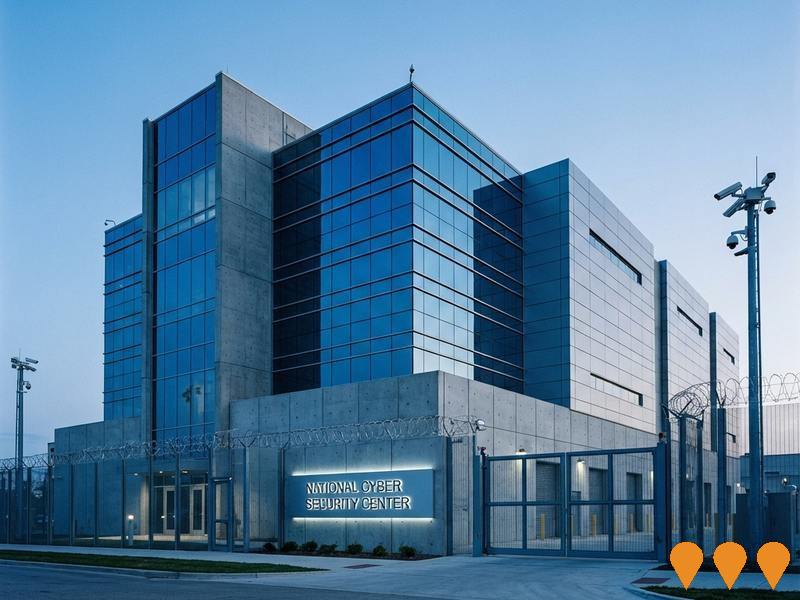Chart Color Schemes
est. as @ -- *
ABS ERP | -- people | --
2021 Census | -- people
Sales Activity
Curious about local property values? Filter the chart to assess the volume and appreciation (including resales) trends and regional comparisons, or scroll to the map below view this information at an individual property level.
Find a Recent Sale
Sales Detail
Population
Tumbarumba is positioned among the lower quartile of areas assessed nationally for population growth based on AreaSearch's assessment of recent, and medium term trends
Tumbarumba's population is 3,613 as of November 2025. This figure reflects a growth of 91 people since the 2021 Census, which recorded a population of 3,522. The increase is inferred from ABS estimated resident population data for June 2024 (3,544) and validated new addresses since the Census date (62). This results in a population density of 0.80 persons per square kilometer. Tumbarumba's growth rate of 2.6% exceeds the SA3 area average of 2.1%, indicating it as a region leader. Overseas migration contributed approximately 93.8% of overall population gains recently.
AreaSearch uses ABS/Geoscience Australia projections for each SA2 area, released in 2024 with a base year of 2022. For areas not covered by this data, NSW State Government's SA2 level projections from 2022 (base year: 2021) are utilized. Growth rates by age group are applied to all areas for years 2032 to 2041. By 2041, the area's population is projected to decrease by 11 persons. However, specific age cohorts like the 75-84 group are expected to grow, with a projected increase of 82 people.
Frequently Asked Questions - Population
Development
AreaSearch assessment of residential development drivers sees a low level of activity in Tumbarumba, placing the area among the bottom 25% of areas assessed nationally
Tumbarumba has received approximately 12 dwelling approvals annually. Between financial years FY-21 and FY-25, a total of 63 homes were approved, with an additional 2 approved in FY-26 to date. Over these five years, an average of 0.6 new residents per year was associated with each dwelling constructed.
This rate suggests that new construction is meeting or exceeding demand, providing more options for buyers and potentially facilitating population growth beyond current projections. The average expected construction cost value of new homes in Tumbarumba is $295,000. In FY-26 alone, $7.0 million in commercial development approvals have been recorded, indicating the area's predominantly residential nature. Compared to the Rest of NSW, Tumbarumba has experienced a 15.0% higher construction rate per person over the past five years, balancing buyer choice while supporting current property values.
However, building activity has slowed in recent years. The majority of development in Tumbarumba consists of detached houses, preserving its low-density nature and attracting space-seeking buyers. As of now, there are an estimated 737 people in the area for each dwelling approval, reflecting a quiet and low-activity development environment. With population projections indicating stability or decline, housing demand pressures in Tumbarumba are expected to remain relatively stable, benefiting potential buyers.
Frequently Asked Questions - Development
Infrastructure
Tumbarumba has emerging levels of nearby infrastructure activity, ranking in the 37thth percentile nationally
AreaSearch has identified 15 infrastructure projects that could impact the area's performance. Key projects include Batlow Water Security (Concept Design) Project, Talbingo Battery Energy Storage System, Snowy 2.0 Transmission Connection Project, and Tumut River Works Program. The following list details those likely to be most relevant.
Professional plan users can use the search below to filter and access additional projects.
INFRASTRUCTURE SEARCH
 Denotes AI-based impression for illustrative purposes only, not to be taken as definitive under any circumstances. Please follow links and conduct other investigations from the project's source for actual imagery. Developers and project owners wishing us to use original imagery please Contact Us and we will do so.
Denotes AI-based impression for illustrative purposes only, not to be taken as definitive under any circumstances. Please follow links and conduct other investigations from the project's source for actual imagery. Developers and project owners wishing us to use original imagery please Contact Us and we will do so.
Frequently Asked Questions - Infrastructure
Snowy 2.0 Pumped Hydro Project
Snowy 2.0 is a 2,200 MW pumped-hydro expansion of the existing Snowy Mountains Scheme, connecting Tantangara and Talbingo reservoirs via 27 km of tunnels and a new underground power station capable of storing 350 GWh. Major works include three TBMs (Florence, Kirsten, Lady Eileen Hudson), excavation of the underground powerhouse cavern, intake/outlet structures, and new 500 kV transmission connections. As of December 2025, tunnelling is approximately 60% complete, with Florence and Kirsten progressing steadily after earlier soft-ground challenges. Powerhouse excavation is advancing, and first power remains targeted for late 2028 with full commercial operations in 2029.
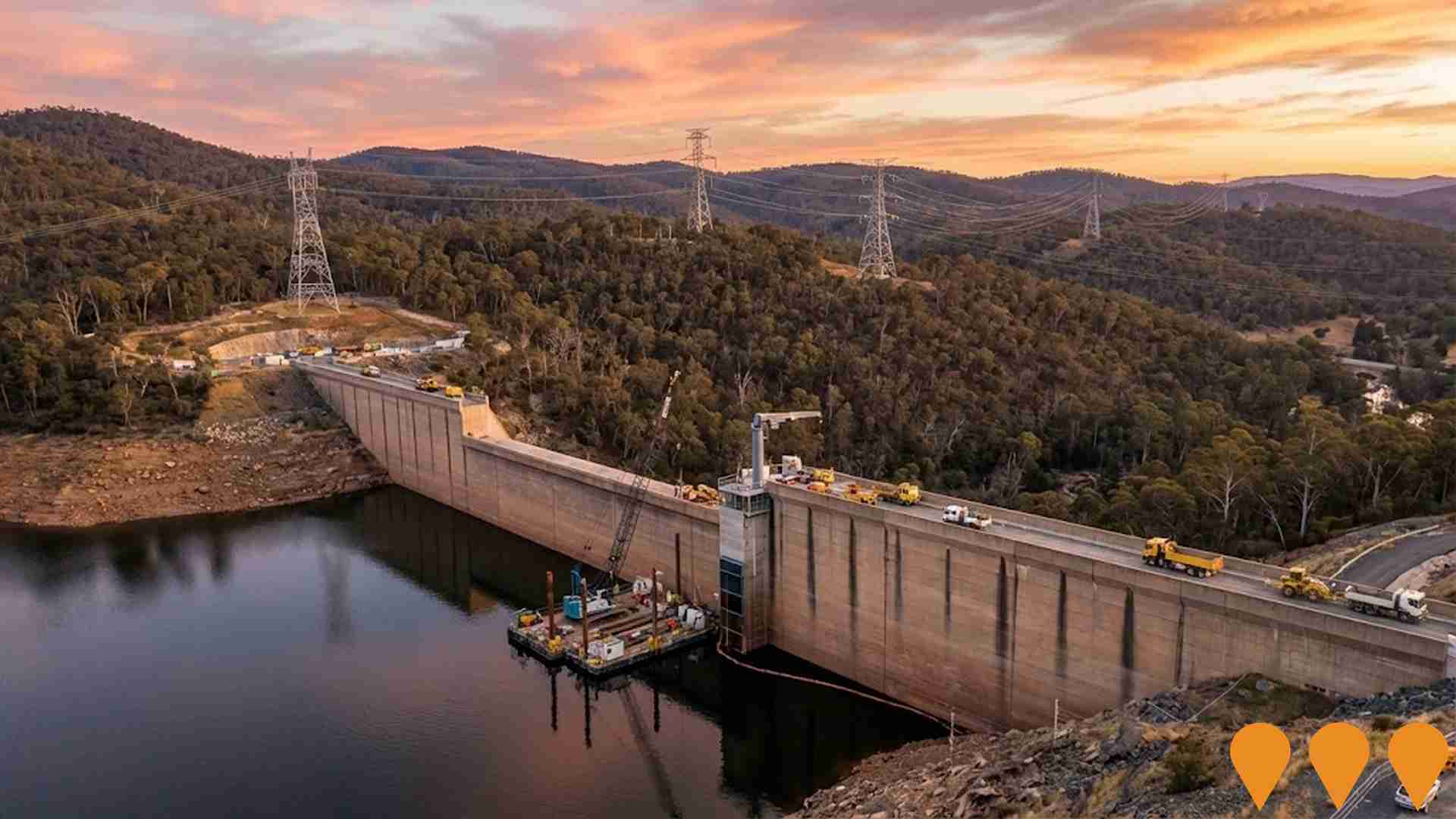
Snowy 2.0
Snowy 2.0 is a pumped-hydro expansion of the Snowy Scheme, linking two reservoirs with tunnels and an underground power station, providing 2,000 MW of power and 350,000 MWh of storage.
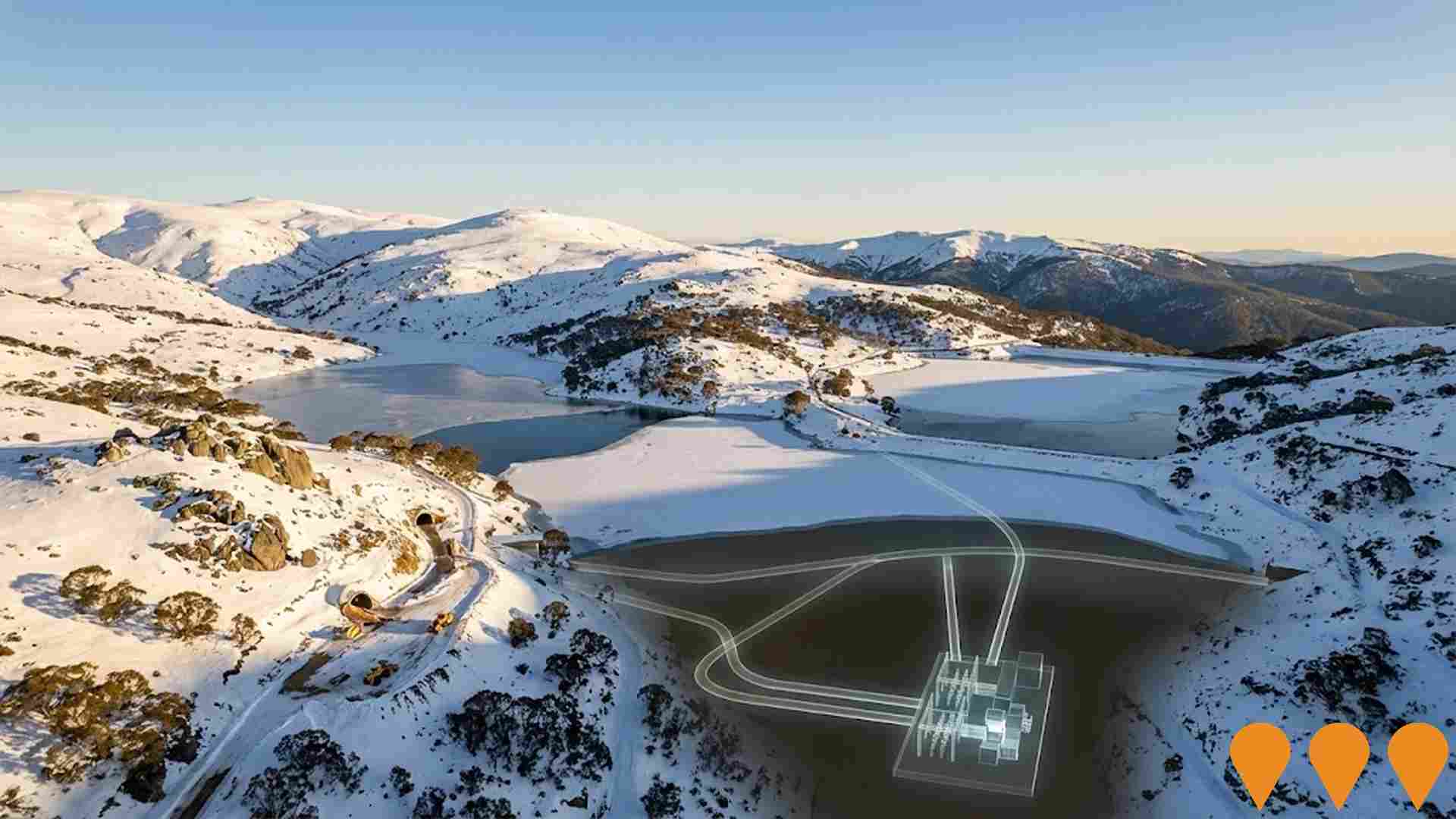
Jindabyne Education Campus
New purpose-built education campus including separate primary and high schools with modern facilities, libraries, halls, playing fields and specialist facilities for art, woodwork, metalwork, music, drama and science. Also includes TAFE NSW Connected Learning Centre. The campus will feature modern facilities to support students, teachers, and the community.

Batlow Water Security (Concept Design) Project
Concept design for a new 50 ML raw water storage to improve long term water security for Batlow. The work is guided by NSW DCCEEW's Regulatory Assurance Framework and delivered by Snowy Valleys Council with NSW Public Works, aiming to take the project to tender ready before detailed design and construction.
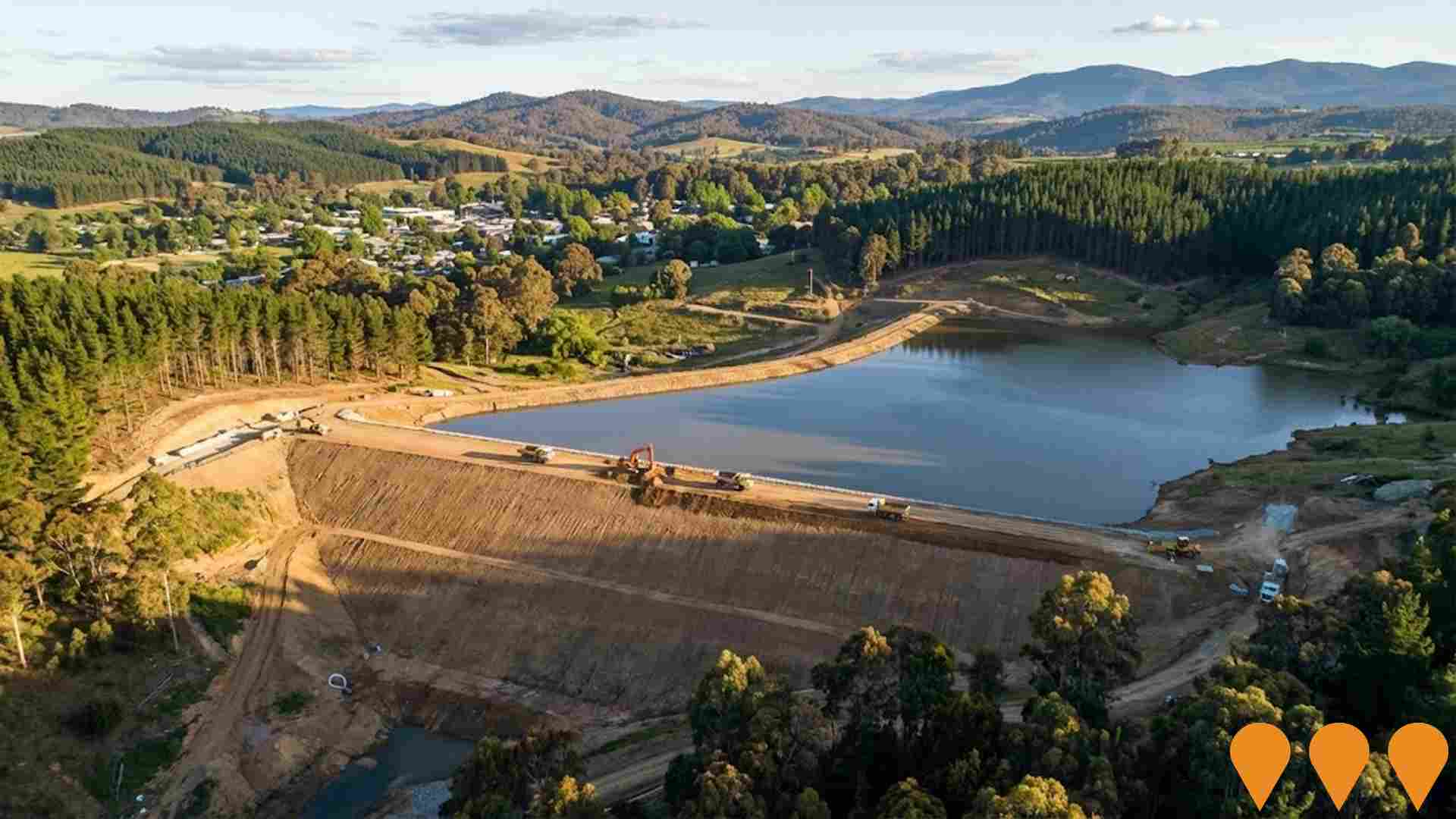
Snowy 2.0 Transmission Connection Project
Approximately 9km of new 330kV double-circuit overhead transmission lines crossing the Tumut River and a new Maragle switching station to connect Snowy 2.0 to the NSW grid and the National Electricity Market. Works include access track upgrades and associated environmental management.

HumeLink
HumeLink is a new 500kV transmission line project connecting Wagga Wagga, Bannaby, and Maragle, spanning approximately 365 km. It includes new or upgraded infrastructure at four locations and aims to enhance the reliability and sustainability of the national electricity grid by increasing the integration of renewable energy sources such as wind and solar.
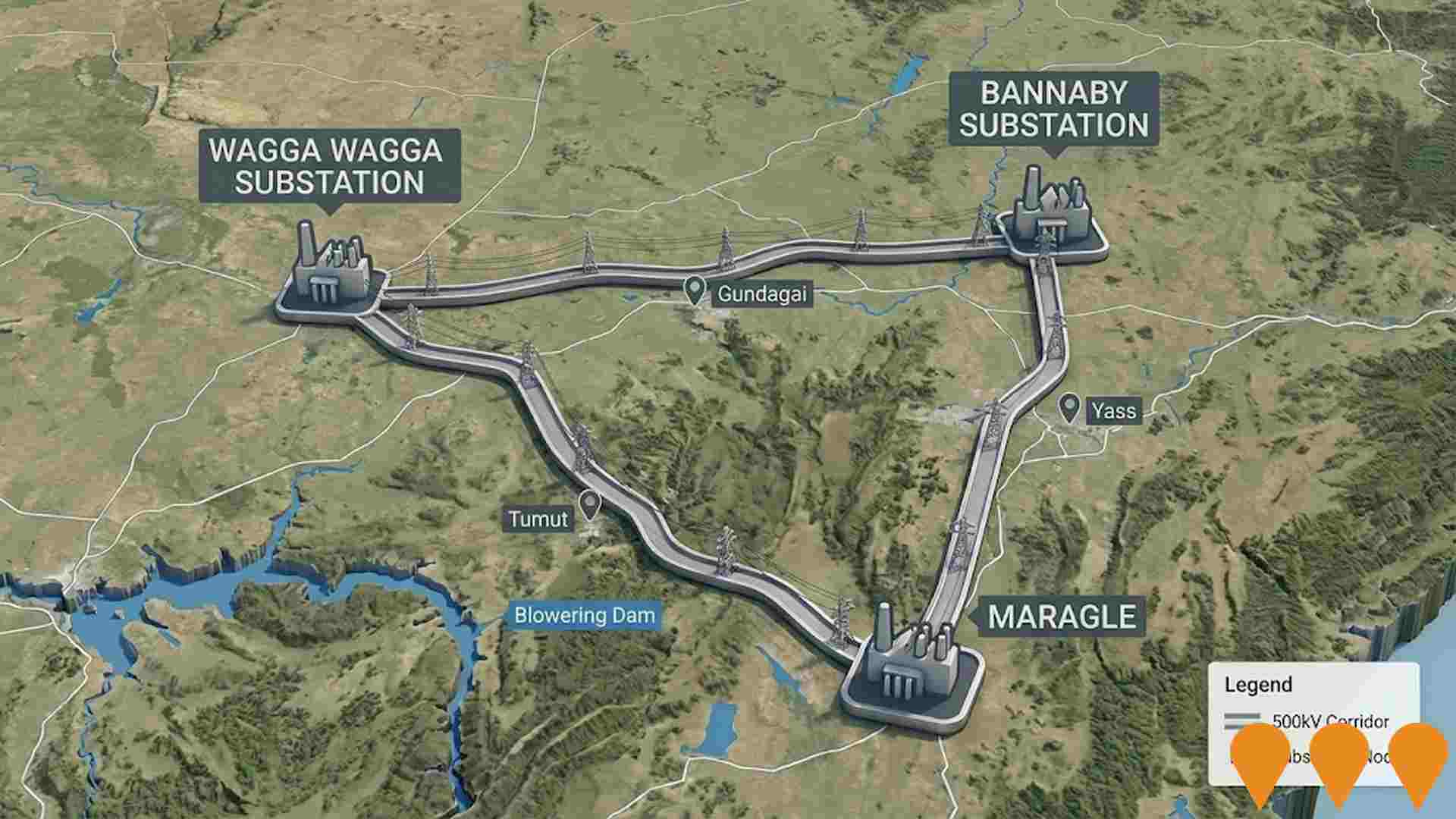
Talbingo Battery Energy Storage System
A 450 MW, 1,800 MWh (4-hour) battery energy storage system (BESS) proposed approximately 700 m from the Tumut 3 Power Station and immediately adjacent to Transgrid's 330 kV Lower Tumut Switching Station, about 2.8 km south of Talbingo. The project has received SEARs and is preparing an Environmental Impact Statement as a State Significant Development. The BESS will provide system services, firm renewable generation, relieve network constraints, and support grid stability.

Thredbo Alpine Coaster
A 1.5km year-round alpine coaster at Thredbo Resort featuring uphill and downhill track sections with a tunnel and bridges. Riders control speed up to 40 km/h. First of its kind in the Southern Hemisphere; now open and operating year-round.
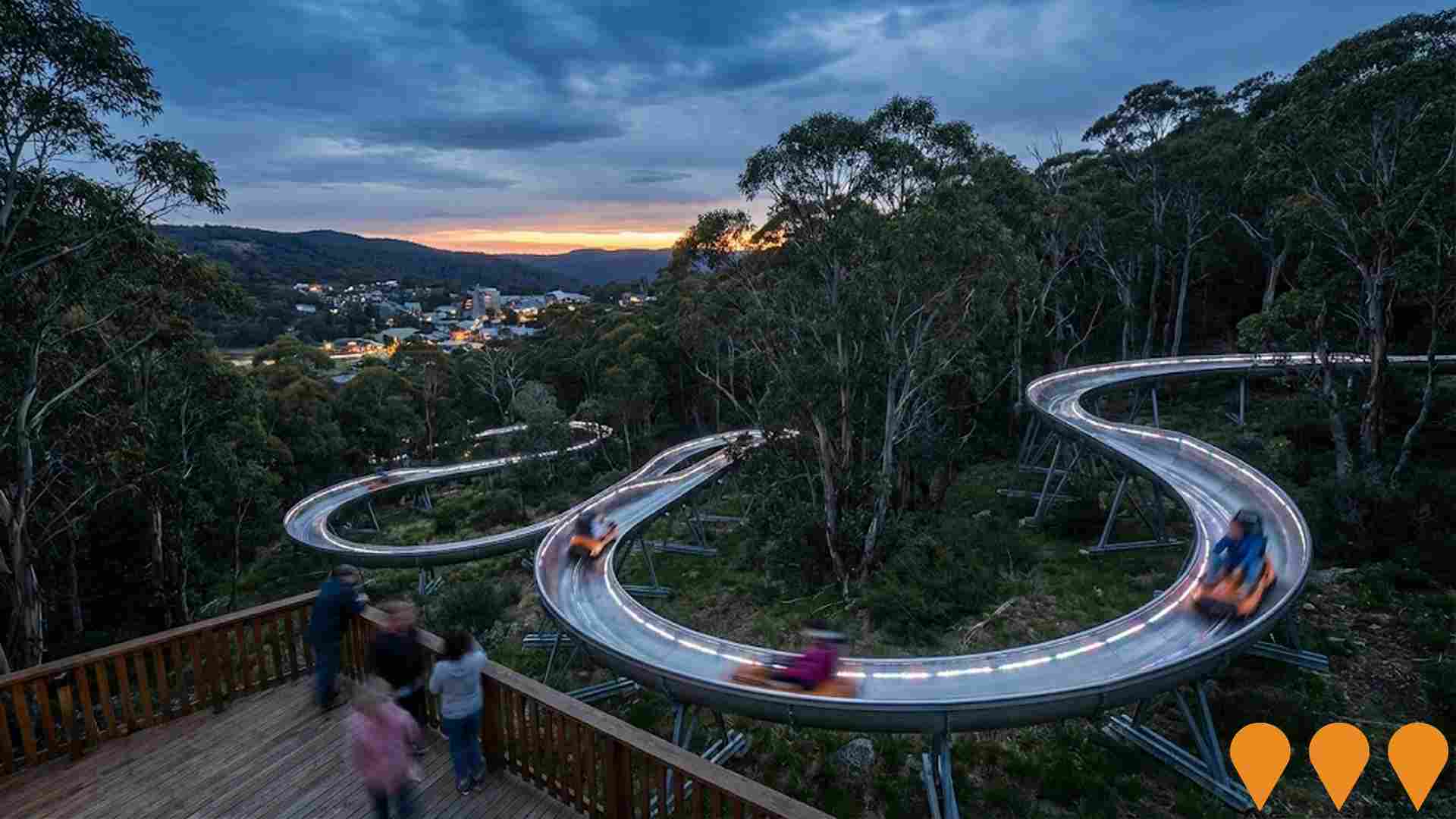
Employment
The labour market in Tumbarumba demonstrates typical performance when compared to similar areas across Australia
Tumbarumba's workforce is balanced across white and blue collar jobs, with diverse sector representation and an unemployment rate of 3.4%. In the past year, ending June 2025, employment grew by 7.6%.
As of that date, 1,636 residents were employed, with an unemployment rate 0.3% lower than Rest of NSW's 3.7%. Workforce participation was 54.1%, compared to Rest of NSW's 56.4%. Key employment sectors include agriculture, forestry & fishing, manufacturing, and public administration & safety. Agriculture, forestry & fishing is particularly notable, with levels at 5.0 times the regional average.
However, health care & social assistance is under-represented, at 8.1% compared to Rest of NSW's 16.9%. Many residents commute elsewhere for work. Between June 2024 and June 2025, employment levels increased by 7.6%, labour force grew by 8.9%, leading to a rise in unemployment by 1.1 percentage points. In contrast, Rest of NSW saw an employment decline of 0.1% and unemployment rose by 0.4 percentage points. National employment forecasts from Jobs and Skills Australia, published in May 2025, project national growth of 6.6% over five years and 13.7% over ten years. Applying these projections to Tumbarumba's employment mix suggests local growth of approximately 4.7% over five years and 10.8% over ten years.
Frequently Asked Questions - Employment
Income
Income levels sit below national averages according to AreaSearch assessment
AreaSearch's latest postcode level ATO data for financial year 2022 indicates Tumbarumba's median income among taxpayers is $48,813. The average income in Tumbarumba during this period was $58,858. Nationally, the median and average incomes were higher at $51,972 and $67,043 respectively. In comparison to other regions, Rest of NSW had a median income of $49,459 and an average income of $62,998 during this time. Based on Wage Price Index growth since financial year 2022, current estimates for Tumbarumba's median and average incomes would be approximately $54,968 and $66,280 respectively as of September 2025. According to Census 2021 income data, household, family, and personal incomes in Tumbarumba rank modestly, between the 23rd and 30th percentiles. The income bracket of $1,500 - 2,999 dominated with 30.0% of residents (1,083 people), aligning with the regional trend where this cohort also represents 29.9%. Housing costs are manageable in Tumbarumba, with 91.4% retained. However, disposable income sits below average at the 33rd percentile.
Frequently Asked Questions - Income
Housing
Tumbarumba is characterized by a predominantly suburban housing profile, with above-average rates of outright home ownership
Tumbarumba's dwelling structure, as per the latest Census, consisted of 97.0% houses and 3.0% other dwellings. This compares to Non-Metro NSW's figures of 92.0% houses and 8.0% other dwellings. Home ownership in Tumbarumba stood at 51.3%, with mortgaged dwellings at 26.3% and rented ones at 22.4%. The median monthly mortgage repayment was $1,127, lower than Non-Metro NSW's average of $1,300. The median weekly rent in Tumbarumba was $208, compared to Non-Metro NSW's figure of $230. Nationally, Tumbarumba's mortgage repayments were significantly lower at $1,127 than the Australian average of $1,863, while rents were substantially below the national figure of $375.
Frequently Asked Questions - Housing
Household Composition
Tumbarumba has a typical household mix, with a lower-than-average median household size
Family households account for 70.5% of all households, including 23.1% couples with children, 36.4% couples without children, and 10.1% single parent families. Non-family households constitute the remaining 29.5%, with lone person households at 27.8% and group households comprising 2.0%. The median household size is 2.3 people, smaller than the Rest of NSW average of 2.4.
Frequently Asked Questions - Households
Local Schools & Education
Tumbarumba faces educational challenges, with performance metrics placing it in the bottom quartile of areas assessed nationally
The university qualification rate in the area is 16.6%, significantly lower than the NSW average of 32.2%. This disparity presents both a challenge and an opportunity for targeted educational initiatives. Bachelor degrees are the most common at 12.2%, followed by graduate diplomas (2.3%) and postgraduate qualifications (2.1%). Vocational credentials are prominent, with 41.3% of residents aged 15+ holding such qualifications, including advanced diplomas (9.7%) and certificates (31.6%).
Educational participation is high, with 30.2% of residents currently enrolled in formal education. This includes primary education (12.0%), secondary education (8.8%), and tertiary education (2.0%). Tumbarumba's five schools have a combined enrollment of 438 students. The area has four primary schools and one secondary school, serving distinct age groups.
Frequently Asked Questions - Education
Schools Detail
Nearby Services & Amenities
Transport
Transport servicing is low compared to other areas nationally based on assessment of service frequency, route connectivity and accessibility
Tumbarumba has 195 active public transport stops. These include both train and bus services. There are 16 different routes operating in total, providing 142 weekly passenger trips combined.
The accessibility of these services is rated as good, with residents typically living within 205 meters of the nearest stop. On average, there are 20 trips per day across all routes, which equates to approximately 0 weekly trips per individual stop.
Frequently Asked Questions - Transport
Transport Stops Detail
Health
Health performance in Tumbarumba is well below average with prevalence of common health conditions notable across both younger and older age cohorts
Health data indicates significant challenges for Tumbarumba, with high prevalence of common health conditions across both younger and older age groups. Approximately 49% (~1,773 people) have private health cover, lower than the national average of 55.3%.
The most prevalent medical conditions are arthritis (11.2%) and asthma (8.9%). Around 62.8% of residents report no medical ailments, similar to Rest of NSW at 62.9%. Tumbarumba has a higher proportion of seniors aged 65 and over, with 28.7% (1,036 people), compared to 24.8% in Rest of NSW. Health outcomes among seniors are above average, outperforming the general population in health metrics.
Frequently Asked Questions - Health
Cultural Diversity
Tumbarumba is considerably less culturally diverse than average when assessed alongside AreaSearch's national rankings for language and cultural background related metrics
Tumbarumba had a cultural diversity score below average, with 85.8% of its population being citizens, 89.3% born in Australia, and 96.7% speaking English only at home. Christianity was the predominant religion in Tumbarumba, comprising 61.4% of people, compared to 65.3% across Rest of NSW. The top three ancestry groups were Australian (32.2%), English (31.4%), and Scottish (9.0%).
Notably, German was overrepresented at 4.7%, Australian Aboriginal was at 4.4%, and Maltese was at 0.5%.
Frequently Asked Questions - Diversity
Age
Tumbarumba hosts an older demographic, ranking in the top quartile nationwide
Tumbarumba's median age is 47 years, which is significantly higher than the Rest of NSW average of 43 years and substantially exceeds the national average of 38 years. The age profile shows that those aged 65-74 are particularly prominent, making up 16.2% of the population, while those aged 25-34 are comparatively smaller at 8.5%. This concentration of those aged 65-74 is well above the national average of 9.4%. Between 2021 and present, the 65 to 74 age group has grown from 13.9% to 16.2%, while the 15 to 24 cohort increased from 8.8% to 10.2%. Conversely, the 55 to 64 cohort has declined from 15.5% to 13.8% and the 25 to 34 group dropped from 9.7% to 8.5%. By 2041, Tumbarumba is expected to see notable shifts in its age composition. The 75 to 84 group will grow by 17 people, reaching 387 from 332, and those aged 65 and above will comprise 72% of the projected population growth. Conversely, population declines are projected for those aged 0-4 and 15-24.




